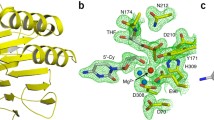Abstract
APE1 (apurinic/apyrimidinic endodeoxyribonuclease 1) is a central enzyme of the base excision repair (BER) pathway playing a pivotal role in protecting mammalian cells against genotoxins and in safeguarding genome stability. Recently, we demonstrated the APE1 ability to process abasic ribonucleotides embedded in DNA. Here, we provide a pipeline of protocols to quantify endodeoxyribonuclease activity by APE1 on these substrates, by using recombinant protein and whole-cell extracts. The repair capacity is measured by using fluorescent oligonucleotide substrates, which are then separated by polyacrylamide gel electrophoresis and detected by imaging scanning. The specificity of APE1 action is demonstrated using specific APE1 enzymatic inhibitors.
Access this chapter
Tax calculation will be finalised at checkout
Purchases are for personal use only
Similar content being viewed by others
References
Malfatti MC, Antoniali G, Codrich M et al (2020) New perspectives in cancer biology from a study of canonical and non-canonical functions of base excision repair proteins with a focus on early steps. Mutagenesis 35:129–149
Antoniali G, Malfatti MC, Tell G (2021) Chapter 17. Emerging concepts on the early steps of base excision repair pathway with a focus on gene expression. In: DNA damage, DNA repair and disease, vol 2, pp 24–47
Rai G, Vyjayanti VN, Dorjsuren D et al (2012) Synthesis, biological evaluation, and structure-activity relationships of a novel class of apurinic/apyrimidinic endonuclease 1 inhibitors. J Med Chem 55:3101–3112
Poletto M, Malfatti MC, Dorjsuren D et al (2016) Inhibitors of the apurinic/apyrimidinic endonuclease 1 (APE1)/nucleophosmin (NPM1) interaction that display anti-tumor properties. Mol Carcinog 55:688–704
Malfatti MC, Balachander S, Antoniali G et al (2017) Abasic and oxidized ribonucleotides embedded in DNA are processed by human APE1 and not by RNase H2. Nucleic Acids Res 45:11193–11212
Tell G, Wilson DM, Lee CH (2010) Intrusion of a DNA repair protein in the RNome world: is this the beginning of a new era? Mol Cell Biol 30:366–371
Malfatti MC, Antoniali G, Codrich M, Tell G (2021) Coping with RNA damage with a focus on APE1, a BER enzyme at the crossroad between DNA damage repair and RNA processing/decay. DNA Repair (Amst) 104:103133
Sparks JL, Chon H, Cerritelli SM et al (2012) RNase H2-initiated ribonucleotide excision repair. Mol Cell 47:980–986
Liu Y, Rodriguez Y, Ross RL et al (2020) RNA abasic sites in yeast and human cells. Proc Natl Acad Sci U S A 117:20689–20695
Cile Mingard C, Wu J, Mckeague M, Sturla SJ (2020) Next-generation DNA damage sequencing. Chem Soc Rev 49:7354–7377
Esqueda A, Mohammed MZ, Madhusudan S, Neamati N (2012) Purification and specific assays for measuring APE-1 endonuclease activity. Methods Mol Biol 928:161–174
Simeonov A, Kulkarni A, Dorjsuren D et al (2009) Identification and characterization of inhibitors of human apurinic/apyrimidinic endonuclease APE1. PLoS One 4:e5740
Acknowledgements
The authors thank all the members of the GT lab for constructive feedback during the development of this work. GT is supported by a grant from the Associazione Italiana per la Ricerca sul Cancro (IG19862).
Author information
Authors and Affiliations
Corresponding author
Editor information
Editors and Affiliations
Rights and permissions
Copyright information
© 2023 The Author(s), under exclusive license to Springer Science+Business Media, LLC, part of Springer Nature
About this protocol
Cite this protocol
Malfatti, M.C., Antoniali, G., Tell, G. (2023). In Vitro Assay to Measure APE1 Enzymatic Activity on Ribose Monophosphate Abasic Site. In: Bhakat, K.K., Hazra, T.K. (eds) Base Excision Repair Pathway. Methods in Molecular Biology, vol 2701. Humana, New York, NY. https://doi.org/10.1007/978-1-0716-3373-1_2
Download citation
DOI: https://doi.org/10.1007/978-1-0716-3373-1_2
Published:
Publisher Name: Humana, New York, NY
Print ISBN: 978-1-0716-3372-4
Online ISBN: 978-1-0716-3373-1
eBook Packages: Springer Protocols




